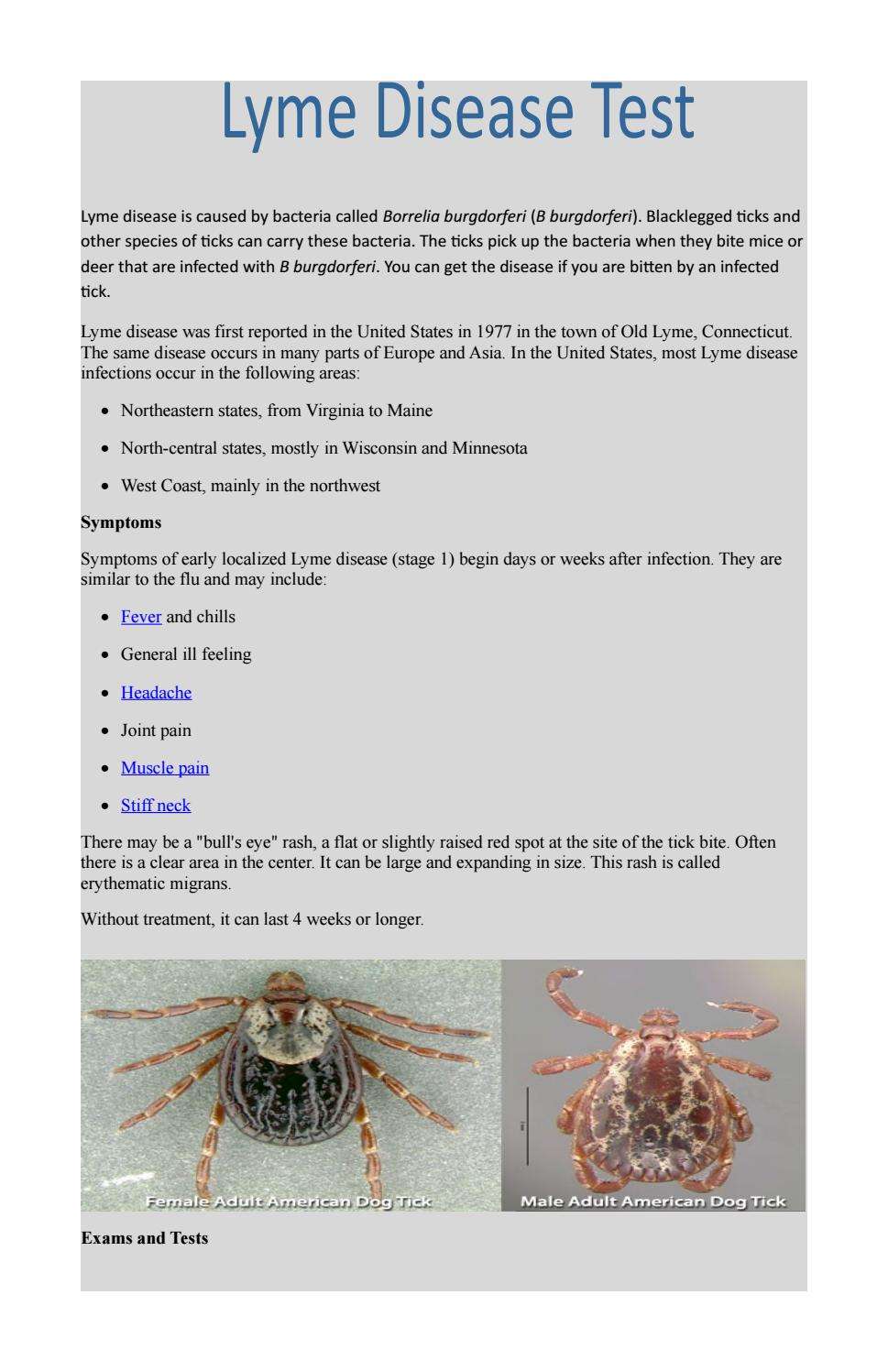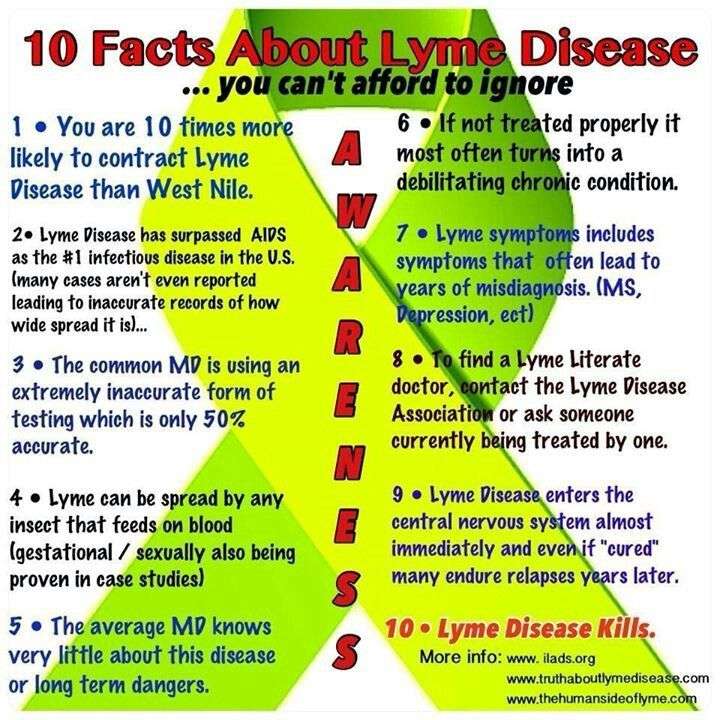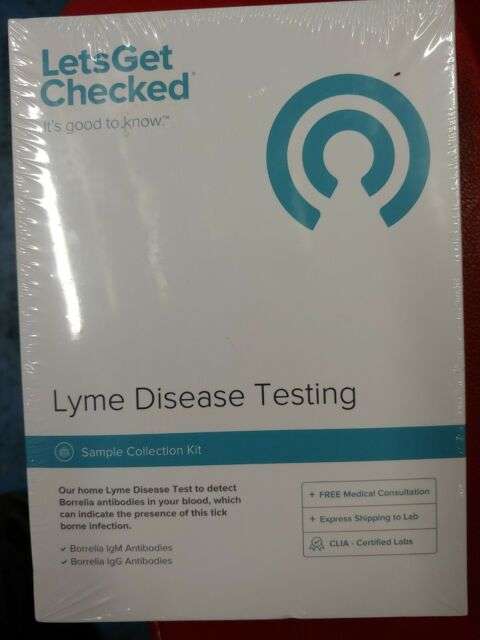Serological Testing Of Serum For The Diagnosis Of Lyme Disease
The most commonly used tests look for antibodies to the Borrelia species that cause Lyme disease in the UK and Europe, but they also detect infections from strains of Borrelia from the US.
The antibody response takes several weeks to reach a detectable level, so antibody tests in the first few weeks of infection may be negative. If the first sample was taken within 4 weeks from the start of symptoms and is negative and there is a clinical suspicion of Lyme disease, then retesting in 4 to 6 weeks may be useful.
It is very rare for patients to have negative antibody tests in longstanding infections. Borrelia antibodies persist indefinitely in some patients and this does not indicate continuing disease or a need for re-treatment.
Serological testing for Lyme disease in the UK and much of the world follows a two-step approach using commonly available antibody screening tests as a first stage, followed by immuno-blotting of samples that give positive or indeterminate results in the screening tests.
Sensitive screening tests are used at the first stage of testing but have the disadvantage of occasionally detecting other diseases and producing false positive results. RIPL uses the C6 Lyme ELISA for screening
Samples giving positive or indeterminate preliminary screening test results are then tested in a more specific system to confirm the presence of Borrelia-specific antibodies. RIPL uses the Borrelia ViraChip® IgG, IgM test for this purpose
When Should I Get A Lyme Disease Test
Lyme disease testing is only recommended under certain circumstances. In general, antibody tests are conducted when you have symptoms of Lyme disease and a confirmed or likely exposure to ticks that are known to carry Borrelia. In these cases, the timing of testing is important. Because antibodies may not form for a few weeks, testing soon after a tick bite or development of a skin rash may cause misleading results.
Antibody testing is not advised if you do not have symptoms of Lyme disease, including for people who live in areas that are confirmed to have the types of ticks that can transmit Borrelia. Testing is also not recommended if you have general symptoms, such as joint pain, but no likely exposure to Borrelia-carrying ticks.
If you have had a tick bite and/or symptoms of Lyme disease, you should talk with your doctor who can address whether Lyme disease antibody testing is appropriate in your situation.
Where Is Lyme Disease Found
In the United States, Lyme disease has been reported in every state, but over 95% of cases are from the Northeastern, Mid-Atlantic, and upper Midwestern states, with a small number of cases reported along the West Coast, especially Northern California. In Canada, Lyme-positive dogs are found mostly in southern Ontario and southern Manitoba, with a small number of cases in southern Quebec and the Maritime provinces.
You May Like: Lyme Disease Doctors In Virginia
Who Should Get Testing
Testing is usually indicated if a person has symptoms of Lyme disease and a known or possible exposure to ticks that can carry the Borrelia bacteria. However, because it takes time for antibodies to develop, the timing of testing is important to consider.
Lyme disease symptoms depend on the extent of the bacterial infection. Three phases are used to describe the infection:
It is important to understand these phases because testing is not equally valuable in each stage. With early localized disease and erythema migrans, blood testing is generally not helpful because antibodies have not had enough time to develop.
Because of similar concerns about potential false positive results, random screening for Lyme disease in people without symptoms is not recommended even in areas that are known to have ticks that can carry the Borrelia bacteria.
When Not To Take This Lyme Disease Test

Do not take this Lyme disease antibody test if:
- You are experiencing a round rash after a tick bite, such as the typical bullseye rash associated with early Lyme disease. Seek immediate medical attention instead of taking this test. A round rash could be a sign of Lyme disease, and it’s best to consult a medical professional and receive treatment as soon as possible to help prevent complications associated with the disease.
- You suspect you might have been infected with Lyme disease bacteria less than 6 weeks ago . The antibodies detected by this test take several weeks to build up in your bloodstream, taking the test before 6 weeks have passed may result in a false negative.
- You havenât lived in or traveled to an area where Lyme disease occurs. Consider discussing any symptoms with your healthcare providerâinstead of taking this testâto help determine if youâve been exposed to a Lyme disease bacterium.
- Youâve previously received a Lyme disease diagnosis, was treated for the disease, and are still symptomatic. Consider discussing any new or ongoing symptoms with your healthcare provider instead of taking this test.
- You are currently being treated for Lyme disease infection or taking antibiotic treatment for other infections. Consider discussing any symptoms with your healthcare provider instead of taking this test.
Because interpreting Lyme disease test results can be difficult, weâve designed your test results to be easy to read and understand.
You May Like: Can You Donate Plasma If You Have Lyme Disease
Sample Types For Lyme Disease Testing
For routine Lyme disease serological testing, you must send a serum sample .
For testing for neurological Lyme disease, you must send paired CSF and serum samples taken on the same day. If possible, please provide CSF cell count and total albumin, IgG and IgM values. If albumin, IgG and IgM measurements are not available, RIPL will make arrangements for these measurements at additional cost.
PCR testing is available. We recommend that specialists call RIPL to discuss appropriate sample types for PCR. These may include joint fluid, biopsy tissue, CSF and EDTA plasma. Please submit biopsies as fresh tissue in a sterile container, ideally with a drop of sterile saline to prevent the tissue drying out.
Why Lyme Is Tough To Diagnose
- Lyme symptoms are similar to other illnesses, so misdiagnosis is common.
- Many Canadian doctors are unfamiliar with Lyme, so they dont test for it or administer the wrong tests.
- Only a handful of blood tests effectively detect Lyme bacteria, so the infection is often missed.
Dont get discouraged if you get a negative diagnosis. Seek out second, and even third, opinions if you must!
Also Check: Homes For Sale Old Lyme Ct
Lyme Disease Test Western Blot
Labs performing a Western blot use electricity to separate proteins called antigens into bands. The read-out from the Western blot looks like a bar code. The lab compares the pattern produced by running the test with your blood to a template pattern representing known cases of Lyme disease. If your blot has bands in the right places, and the right number of bands, it is positive.
The CDC requires 5 out of 10 bands for a positive test result. However, because some bands on the Western blot are more significant than others your doctor may decide you have Lyme disease even if your Western blot does not have the number of bands or specific bands recommended by the CDC. Different laboratories use different methods and criteria for interpreting the test, so you can have a positive test result from one lab and a negative test result from another.
For a comprehensive explanation of the western blot test, download Understanding Western Blot Lyme disease test.
The chart below will help you understand how to interpret the western blot test.
Notice To Readersrecommendations For Test Performance And Interpretation From Thesecond National Conference On Serologic Diagnosis Of Lyme Disease
The Association of State and Territorial Public HealthLaboratory Directors, CDC, the Food and Drug Administration, theNational Institutes of Health, the Council of State and TerritorialEpidemiologists, and the National Committee for Clinical LaboratoryStandards cosponsored the Second National Conference on SerologicDiagnosis of Lyme Disease held October 27-29, 1994. Conferencerecommendations were grouped into four categories: 1) serologictest performance and interpretation, 2) quality-assurancepractices, 3) new test evaluation and clearance, and 4)communication of developments in Lyme disease testing. Thisreport presents recommendations for serologic test performance andinterpretation, which included substantial changes in therecommended tests and their interpretation for the serodiagnosis ofLD.
It was recommended that an IgM immunoblot be consideredpositive if two of the following three bands are present: 24 kDa * , 39 kDa , and 41 kDa . It was furtherrecommended that an that IgG immunoblot be considered positive iffive of the following 10 bands are present: 18 kDa, 21 kDa *,28 kDa, 30 kDa, 39 kDa , 41 kDa , 45 kDa, 58 kDa , 66 kDa, and 93 kDa .
The details of both plenary sessions and the work groupdeliberations are included in the publication of the proceedings,which is available from the Association of State and TerritorialPublic Health Laboratory Directors telephone 822-5227.
Don’t Miss: Old Lyme Shores Homes For Sale
The Elisa And Western Blot Are Not Sensitive Enough
Another major limiting factor of the traditional ELISA and Western blot is the quality. These tests tend to use lysed BB cultures, and therefore, depending on the culture conditions, some antigens are over-expressed, and some are under-expressed. This, in turn, can affect the ability to detect antibodies from patients blood.
Whats more, if a patient tests too early after a tick bite, his or her body may not have produced enough antibodies to show up on a test with suboptimal sensitivity.
Negative C6 Elisa On Serum
Early clinical Lyme disease in the form of erythema migrans with associated history of a tick bite should be treated empirically. There is no need for testing unless there are further symptoms.
A negative ELISA result in the early stages of Lyme disease does not exclude infection. If acute Lyme disease is suspected but serology results are negative, we recommend that the test is repeated in 4-6 weeks with a fresh sample to look for seroconversion.
In patients with long term symptoms a negative ELISA test usually excludes Lyme disease as a cause of these symptoms. Information on differential diagnosis for patients with persistent symptoms and negative Lyme disease serology results is available.
Read Also: Full Recovery From Lyme Disease
Everlywell Lyme Disease Test
Everlywells Lyme Disease Test checks for a persons exposure to any of the three strains of Borrelia bacteria. The test is suitable for those experiencing fatigue, headaches, or joint pain. The test offers a fingerprick sample collection.
Once people receive their kits, they can register them online, collect their sample, and return it to the labs using the prepaid shipping labels. They can access their results through their online dashboards.
The kit costs $109.
There are some advantages that Everlywell services offer:
- It works with CLIA-certified labs.
- Independent board-certified physicians review and approve peoples tests.
- It offers free shipping.
QuestDirects Lyme Disease Test is available in person. People purchase their test and book an appointment with a nearby Quest Patient Service Center, where a medical professional collects the sample.
They then receive their results through their MyQuest accounts.
The cost for the test is $89, with an additional $6 fee that covers the physicians visit.
Pros and cons
QuestDirect has some advantages. Firstly, the MyQuest portal allows individuals to view their results online. Additionally, the companys health team can contact the customer if their results require prompt attention.
However, disadvantages include the fact that there is an additional physician fee. The service is also unable to provide a receipt for health plan reimbursement.
Management Of Individuals Without Symptoms Following A Tick Bite

Diagnostic testing is not recommended for individuals who do not develop any symptoms suggestive of Lyme disease after a tick bite.
Some commercial companies offer services to test removed ticks for the presence of the bacteria that cause Lyme disease. PHE does not provide such tick-testing services. The results of such tests should not be used to inform diagnosis or treatment. A positive result does not mean that the infected tick will have passed on the bacteria there are many factors that determine whether Lyme disease results from the bite of an infected tick. A negative result may not be technically valid and could give false assurance, as it does not exclude the possibility that another tick elsewhere on the body has been missed by the patient.
PHE runs a tick surveillance scheme and is happy to receive ticks for species identification and to monitor tick distribution.
Recommended Reading: Signs My Dog Has Lyme Disease
You Do Not Usually Need Tests To Show That You Have Lyme Disease
In most cases, theres a clear sign of Lyme diseasea painless, spreading rash that often grows to look like a bulls eye. If you have this rash, and you recently had a tick bite or were in an area known for Lyme disease, you dont need a test. Instead, your doctor can just start treating you with antibiotics, as appropriate.
Serological Testing Of Csf For The Diagnosis Of Neurological Lyme Disease
Serological testing for neurological Lyme disease is based on demonstrating intrathecal synthesis of Borrelia-specific antibodies in CSF. For laboratory testing for neurological Lyme disease, separate IgG and IgM ViraChip® serology assays are performed on CSF and paired serum and the results compared.
CSF samples must be tested in parallel with a contemporaneous serum sample and protein and immunoglobulin levels compared between the two sample types to produce a meaningful result.
For necessary sample types and volumes see Sample types for Lyme disease testing
Don’t Miss: Cottages For Rent In Old Lyme Ct
Lyme Disease Laboratory Tests Available At Ripl
The primary service provided by RIPL is serological testing using well-characterised and validated screening and confirmatory tests in accordance with the NICE Lyme disease guideline.
RIPL participates in regular external quality assurance exercises as an independent measure of its performance.
Details of prices and turnaround times for Lyme testing are provided in Appendix 1 of the RIPL user manual.
What If Your Lyme Disease Test Is Positive
Its important to note that a positive result doesnt mean you have a diagnosis of Lyme disease. The tests will show that antibodies are present in your blood, but a physician will need to order another type of test before you get an official diagnosis.
If someone gets a positive at-home test, definitely see your doctor, says Dr. Puja Uppal, a board certified family medicine physician and the chief medical officer at Think Healthy.
A physician will likely order both an enzyme-linked immunosorbent assay and a Western blot test, which check for antibodies specific to Borrelia burgdorferi. They will consider the results of both these tests, along with your symptoms, to make an accurate diagnosis.
You May Like: Lyme Disease And Muscle Pain
How Can I Tell If Treatment Is Working
If joint lameness is the presenting sign, improvement may be noted after 3-5 days starting antibiotics. A dog’s response to therapy can be assessed by repeating the QC6 test six months after treatment is complete. Dogs that start with a moderate to high QC6 value typically show a 50% reduction or more in the QC6 at six months, indicating that treatment has been successful. Dogs that have a lower initial QC6 value may not show such dramatic reductions in the QC6 at six months, although the value should still be lower than the starting point if treatment has been successful.
A persistently high QC6 suggests treatment may not have been complete or that the dog became reinfected after treatment was stopped.
How We Chose The Best At
When evaluating the companies for the best at-home Lyme disease tests, we looked at several key factors in order to provide you with the best information. For one, accuracy was extremely important, so we looked at testing centers with the best reviews and certifications. Every test mentioned in this article has been evaluated and awarded for their laboratory accuracy when dealing with their at-home tests.
Since Lyme disease is so severe and a misdiagnosis can have awful repercussions, we also considered how others reviewed the at-home tests.
Recommended Reading: Ways To Test For Lyme Disease
Where Lyme Disease Occurs
In the United States, Lyme disease typically occurs in the Northeast, Mid-Atlantic, and North Central states. It has also been reported to occur in Northern California. The most prevalent strain causing Lyme Disease in the United States is Borrelia burgdorferi.
If you live or have traveled to a state where Lyme disease is endemic, this increases your risk. Lyme disease is endemic in the following states: California, Connecticut, Delaware, Maine, Maryland, Massachusetts, Minnesota, New Hampshire, New Jersey, New York, Pennsylvania, Rhode Island, Vermont, Virginia, Washington DC, West Virginia, and Wisconsin. For regulatory reasons, Everlywell is not able to offer testing in New Jersey, New York, or Rhode Island.
Access To Lyme Disease Testing Services

This guidance on the laboratory diagnosis of Lyme disease is intended for healthcare professionals in the UK. Patients concerned about possible Lyme infection should consult an appropriate healthcare professional, for example their GP, in the first instance.
Health professionals wishing to discuss a possible case or ascertain local arrangements for testing should contact a local Infection specialist .
NHS testing for Lyme disease is available through local service providers and the Rare and Imported Pathogens Laboratory at PHE Porton where ISO15189 accredited confirmatory testing is also provided. RIPL is also introducing a testing service for neurological Lyme disease.
RIPL provides medical and laboratory specialist services to the NHS and other healthcare providers, covering advice and diagnosis of a wide range of unusual bacterial and viral infections, including Lyme disease.
RIPL continuously updates its methods and will make further information on Lyme disease diagnostic testing available as it arises.
Don’t Miss: What Are The Effects Of Lyme Disease On The Body